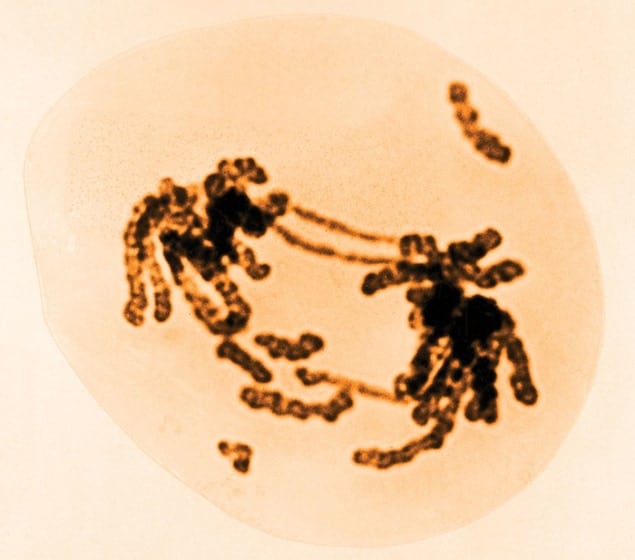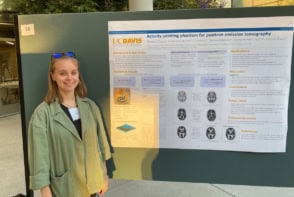Jun Deng reviews Strange Glow: the Story of Radiation by Timothy Jorgensen

One Sunday evening, as I finished reading Timothy Jorgensen’s Strange Glow, I closed the book and turned off the bedside lamps to prepare myself for the next day’s early start. Suddenly, a strong yellow glow caught my eyes. As a medical physicist who deals with X-rays and radioactive materials on a daily basis, I have seen the three-fan radiation symbol countless times, but there, printed on the book cover and shining brightly out of total darkness, it suddenly appeared awful and mysterious. It reminded me of the stories I had just read in Jorgensen’s book, from the very first X-ray image – which famously showed the skeletal ringed hand of Wilhelm Röntgen’s wife – to the innocent “radium girls” who were fatally exposed while painting watch dials with the radioactive paint, and the iconic photos of mushroom clouds rising in the skies of Hiroshima and Nagasaki in August 1945.
Humans have a long-term relationship with radiation. Many radioactive materials have existed for millennia, and some have probably been here ever since the birth of our planet. Yet, only since 1895 – the year Röntgen discovered X-rays in an early version of an X-ray tube invented by William Crookes – have we really started to comprehend the “strange glow” associated with these materials, and to appreciate the mighty power of radiation in treating cancers as well as in inducing them. In many cases, human beings have paid a stiff price for these hard-won lessons.
In Strange Glow, Jorgensen relates a brief history of our dealings with radiation, tracking the most important events and profiling the most pioneering researchers in the field. Through a clear timeline, he describes the discovery of this phenomenon, its health effects, and the risks and benefits of radiation in three distinct sections. All the great discoveries (which all physicist readers should know about and never forget) made by prominent early radiation scientists such as Röntgen, Marie Curie, William Bragg and Thomas Edison are introduced naturally, logically and chronologically. Jorgensen’s lucid writing and strong story-telling skills are demonstrated thoroughly in this book , making it a pleasure to read. Like Stephen Hawking’s A Brief History of Time (which I read a long time ago and still enjoy), Jorgensen’s book introduces only two equations, one on Bragg’s law and the other on Haber’s rule. In its simplicity and conciseness, it greatly contributes to removing some of the mystery and misunderstanding that surrounds radiation.
One real strength of this book is the way it dispels the myth that radiation risks are too complicated for ordinary people to grasp. Jorgensen does this by showing that radiation risks can be estimated effectively without resorting to some “expert” advice or relying on a lot of physics and mathematics background knowledge. This is particularly important in the modern era when radiation has become part of our daily lives, whether it stems from natural sources (such as radon gas in basements), consumer technology (mobile phones, microwaves, airport screening devices and so on) or from medical uses such as diagnostic X-rays, mammography, CT scans and radiation therapy.
Jorgensen, an associate professor of radiation medicine and director of the graduate programme in health physics and radiation protection at Georgetown University, US, has done an excellent job of elucidating many important medical-radiation concepts in layperson’s language. These include radiation-induced DNA damage, effective dose, number needed to treat (NNT) and number needed to harm (NNH). As such, readers can easily develop an objective mindset for assessing the risks of any radiation-related events they encounter. This is to be welcomed, as a more rational perception of radiation risks would help people make sensible decisions on their health – decisions that would reduce rather than increase their risks in the long term.
While a large portion of the book is dedicated to the risks and benefits of radiation, the application of these risks and benefits to the treatment of cancers could be further elaborated. As the author points out, this is a non-trivial task – not least because radiation therapy is primarily used to treat people who already have cancer; every patient and every cancer is different; and even the same cancer in the same patient can respond differently to radiation therapy over time. Hence, personalized radiation therapy with personalized cancer risk assessment would be highly desirable, and is becoming a very hot topic in medical physics research.
In fact, recent epidemiological studies carried out in the UK, France, the US and Australia have confirmed that there is a positive correlation between ionizing radiation and the risk of developing a second cancer in both children and radiation-monitored workers. Mean carcinogenic doses as low as 16 mGy – the sort of dose usually encountered in a CT scan – have been recorded when the targets were radiosensitive organs such as the brain, lungs and red bone marrow. A study carried out by my own group also indicated that the cumulative radiation doses from multiple imaging procedures can be comparable to the “scatter” and “leakage” doses from radiation treatment of cancers – thereby imposing extra risk of developing a second cancer on patients who have already had a primary cancer. This is particularly important for paediatric patients, who are both more vulnerable to the radiation damage and also have a longer life expectancy than the adults.
Mark Twain once described a “classic” as “a book which people praise and don’t read”. In that spirit, then, I will not describe this book as a classic, because I feel it will become a very useful resource to the general public as well as to radiation experts, thanks to its simplicity, conciseness and lucidity. I have certainly learned a lot from the book, as it has helped me project my own perspective on the uses and risks of radiation onto a broader spectrum of issues. I greatly appreciate the author making this book so accessible and readable, and making radiation less formidable than it first appears.
- 2016 Princeton University Press £24.95/$35.00pb 512pp



